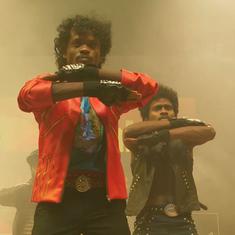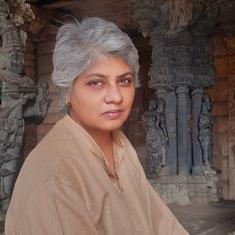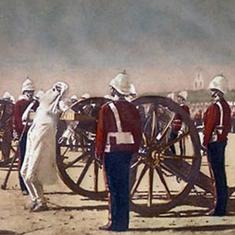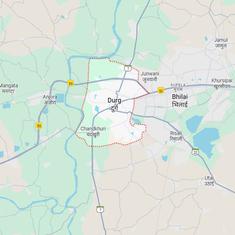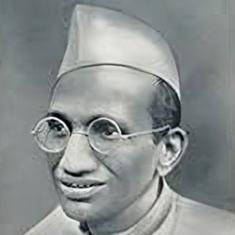Sudhir Patwardhan’s 1981 painting Street Play is a tour de force of political art. Made in the run-up to the massive textile mill strike that convulsed Bombay in 1982, it presents Bombay as a streetscape stitched together from different parts of the metropolis, a sequence of panels. These panels speak to us of the city’s turbulent history, one showing a textile mill with a group of dispirited workers, another presenting a Leftist theatre group’s street performance with the D N Road arcades as backdrop. The artist watches the performance from behind a pillar. An actor, kneeling with his hands outstretched like a crucified Christ, is split between the scene and its reflection in a glass storefront. A car, either passing by or conveying the mill-owner to the mill, is split by the pillar. Although this painting may seem to be realistic in terms of its figuration, it defies the conventions of realism. Its complex mise-en-scene sets up a crisscross of gazes and a bewildering interplay of spaces. There is no simple equivalence between art and ideology here. The artist-persona is more observer than participant, both attracted to and sceptical of collective action. Street Play reveals itself as an expanded psychological portraiture of resistance in its various moments, marked by doubt, conviction, solidarity, dispersal, all taking place in an atmosphere of imminent threat.
Although the subject could not have been more secular, we sense the persistence of the vocabulary of sacred art in Street Play. The actor embodies the figure of the martyr, the Leftist street play could be a version of the medieval passion play. In the unlit arcade, we discern a faint cross. This is not coincidental. While Patwardhan has always loved the art of the Italian Primitives and the Renaissance – much of it devoted to Christian subjects – Marxist circles of the kind he was associated with during the 1970s were exposed to liberation theology. In the action of Street Play, we could see the distant resonances of a new way of experiencing religion – not through the opulence of the Church but through identification with Jesus as a Galilean artisan, a rebel rising up from a colonized population, a voice speaking truth to the power of the Roman Empire.

Street Play continues to exercise its fascination today. I thought of it last week, as I stood with fellow demonstrators at Azad Maidan, protesting against the Citizenship Amendment Act. D N Road is now out-of-bounds for morchas, and Azad Maidan is the designated venue for them. As the demonstration unfolded into a sonic collage, with various groups speaking and listening to speeches, singing and waving banners, it occurred to me that the tension between ideological commitment and sceptical distance, which gives Street Play its melancholy power, has been dissolved by a polycentric form of political expression. The spirit of resistance is no longer driven by a single leader or ideology. Diverse voices now speak truth to power.
Walking Through Soul City, a retrospective of Sudhir Patwardhan’s work, is on display at the National Gallery of Modern Art, Mumbai, till February 12, 2020.
Read all the articles in the Art of Resistance series here.

